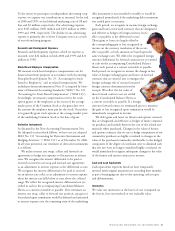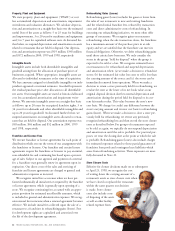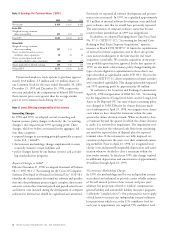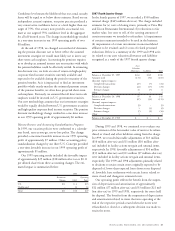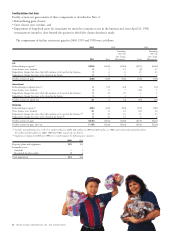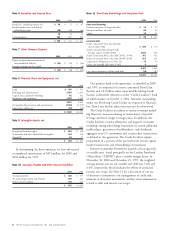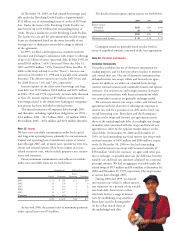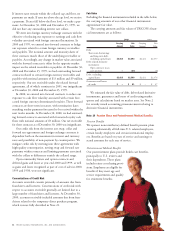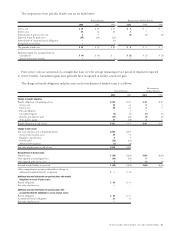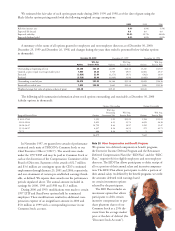Pizza Hut 2000 Annual Report Download - page 51
Download and view the complete annual report
Please find page 51 of the 2000 Pizza Hut annual report below. You can navigate through the pages in the report by either clicking on the pages listed below, or by using the keyword search tool below to find specific information within the annual report.
TRICON GLOBAL RESTAURANTS, INC. AND SUBSIDIARIES 49
1997 Fourth Quarter Charge
In the fourth quarter of 1997, we recorded a $530 million
unusual charge ($425 million after-tax). The charge included
estimates for (a) costs of closing stores, primarily at Pizza Hut
and Tricon Restaurants International; (b) reductions to fair
market value, less costs to sell, of the carrying amounts of
certain restaurants we intended to refranchise; (c) impairments
of certain restaurants intended to be used in the business;
(d) impairments of certain investments in unconsolidated
affiliates to be retained; and (e) costs of related personnel
reductions. Below is a summary of the 1999 and 1998 activ-
ity related to our asset valuation allowances and liabilities
recognized as a result of the 1997 fourth quarter charge:
Asset
Valuation
Allowances Liabilities Total
Balance at December 27, 1997 $261 $129 $390
Amounts used (131) (54) (185)
(Income) expense impacts:
Completed transactions (27) (7) (34)
Decision changes (22) (17) (39)
Estimate changes 15 (7) 8
Other 1–1
Balance at December 26, 1998 97 44 141
Amounts used (87) (32) (119)
(Income) expense impacts:
Completed transactions (5) –(5)
Decision changes 1(3) (2)
Estimate changes (7) (9) (16)
Other 1–1
Balance at December 25, 1999 $÷÷– $÷÷– $÷÷–
During 1999 and 1998, we continued to re-evaluate our
prior estimates of the fair market value of units to be refran-
chised or closed and other liabilities arising from the charge.
In 1999, we recorded favorable adjustments of $13 million
($10 million after-tax) and $11 million ($10 million after-
tax) included in facility actions net gain and unusual items,
respectively. In 1998, favorable adjustments of $54 million
($33 million after-tax) and $11 million ($7 million after-tax)
were included in facility actions net gain and unusual items,
respectively. The 1999 and 1998 adjustments primarily related
to decisions to retain certain stores originally expected to be
disposed of, lower-than-expected losses from stores disposed
of, favorable lease settlements with certain lessors related to
stores closed and changes in estimated costs.
Our operating profit reflects the benefit from the suspen-
sion of depreciation and amortization of approximately
$12 million ($7 million after-tax) and $33 million ($21 mil-
lion after-tax) in 1999 and 1998, respectively, for stores held
for disposal. The benefits from the suspension of depreciation
and amortization related to stores that were operating at the
end of the respective periods ceased when the stores were
refranchised or closed or a subsequent decision was made to
retain the stores.
Confidence level means the likelihood that our actual casualty
losses will be equal to or below those estimates. Based on our
independent actuary’s opinion, our prior practice produced a
very conservative confidence factor at a level higher than our
target of 75%. Our actuary now provides an actuarial esti-
mate at our targeted 75% confidence level in the aggregate
for all self-insured years. The change in methodology resulted
in a one-time increase in our 1999 operating profit of over
$8 million.
At the end of 1998, we changed our method of determin-
ing the pension discount rate to better reflect the assumed
investment strategies we would most likely use to invest any
short-term cash surpluses. Accounting for pensions requires
us to develop an assumed interest rate on securities with which
the pension liabilities could be effectively settled. In estimating
this discount rate, we look at rates of return on high-quality
corporate fixed income securities currently available and
expected to be available during the period to maturity of the
pension benefits. As it is impractical to find an investment
portfolio which exactly matches the estimated payment stream
of the pension benefits, we often have projected short-term
cash surpluses. Previously, we assumed that all short-term cash
surpluses would be invested in U.S. government securities.
Our new methodology assumes that our investment strategies
would be equally divided between U.S. government securities
and high-quality corporate fixed income securities. The pension
discount methodology change resulted in a one-time increase
in our 1999 operating profit of approximately $6 million.
Human Resource and Accounting Standardization Programs
In 1999, our vacation policies were conformed to a calendar-
year based, earn-as-you-go, use-or-lose policy. The change
provided a one-time favorable increase in our 1999 operating
profit of approximately $7 million. Other accounting policy
standardization changes by our three U.S. Concepts provided
a one-time favorable increase in our 1999 operating profit of
approximately $1 million.
Our 1999 operating results included the favorable impact
of approximately $29 million ($18 million after-tax or $0.11
per diluted share) from these accounting changes. The esti-
mated impact is summarized below:
1999
Restaurant Operating
Margin G&A Profit
U.S. $11 $÷4 $15
Unallocated –1414
Total $11 $18 $29








